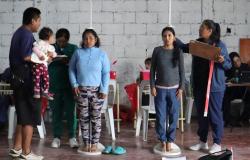(CNN Spanish) –– In a remote corner of the province of Neuquén, in southern Argentina, China observes deep space and a firmament crowded with satellites.
Since the signing of the first agreements between Beijing and Buenos Aires for its construction in 2012, the Deep Space Station managed by the Chinese National Agency for Satellite Launch, Tracking and General Control (CLTC), part of the Chinese People’s Liberation Army (PLA) has generated controversies inside and outside the South American country.
In particular, two questions have been at the center of the controversy: whether its use is effectively only civil, as indicated in the signed agreements, and not military; and the concessions made by Argentina regarding control of these facilities.
The United States, China’s global competitor, has consistently shown its concern about the advance of the Chinese space program in South America, and on March 12 the head of the Southern Command, General Laura Richardson, once again showed before the Armed Services Commission of the House of Representatives its concern for “a deep space station in Argentina, which provides the PLA with global space tracking and surveillance capabilities, which could translate into global military capabilities.”
The Chinese embassy in Buenos Aires reacted with a statement cited by TN stating that “the Far Space Station in Neuquén is a space technological cooperation facility between China and Argentina”, intended only for scientific research.
CLTC – CONAE – NEUQUEN station. (Credit: Government of Argentina)
In any case, it is the first station of this type outside the territory of China, the result of good relations between the governments of the then president Cristina Fernández de Kirchner and the president of China, Xi Jinping, but its construction concluded in 2017. , during the government of Mauricio Macri.
But the triumph of Javier Milei in the presidential elections held in November, a candidate who has indicated that his priority was “to be an ally of the United States,” has also restored the controversy and on Tuesday the Argentine Defense Minister, Luis Petri, assured on the TN network that the government of President Javier Milei was analyzing the original agreement and the possibility of carrying out an inspection.
“We are going to guarantee that the activities carried out there are those established in the agreement, that is, scientific and space, not military,” he said on Tuesday. “There are possibilities of agreeing to inspect, and the decision is to guarantee that the agreement is complied with.”
This is what we know about China’s Deep Space Station in Argentine Patagonia.
When was its construction agreed and what do the signed agreements say?
The cooperation agreement between the Chinese CLTC and the National Commission for Space Activities (CONAE) of Argentina was signed in 2012, in a context of growing commercial, diplomatic and political relations between China and Argentina.
Through this instrument, the establishment of a space observation station was agreed on a 200-hectare plot of land about 60 kilometers north of Las Lajas, in the province of Neuquén, in order to “provide support to the Chinese Exploration Program of Moon”. The agreement has a duration of 50 years, and can be terminated at the request of either party and with 5 years’ notice.
Specifically, the agreement refers to a “Station for ground tracking, command and data acquisition, including an antenna for Deep Space research.”
According to the agreement, CLTC would be the sole operator of the station, and could define the personnel necessary for its maintenance. The CONAE and the province of Nequén, meanwhile, would have a space defined by the CLTC to participate in joint activities. (Note: page 8)
And what’s inside this station? According to the agreement, a deep-space TT&C (tracking, telemetry and command, in English) antenna system, a satellite communications system and “other tracking equipment” that “may be added in the future.”
Several of the articles of the agreement have sparked controversy, especially Article 8, which establishes that the parties will maintain “confidentiality regarding the technologies, activities and programs for monitoring, control and data acquisition.”
Another controversial point is article 6, which establishes that CONAE and the Province of Neuquén are not responsible nationally or internationally for the actions or omissions of CLTC.
In 2014, another agreement was signed, this time between the governments of Argentina and China, for the construction of a station “to provide ground support for Chinese Deep Space exploration missions”, and it was voted by the Argentine Congress in 2015. like law 27,123.
This second agreement generated new controversies, in the first place. by establishing in its article 2 tax exemptions to China during the construction of the station and the purchase of goods for its operation.

Satellite image provided to CNN by BlackSky showing China’s Deep Space station in Neuquén, Argentina. (Credit: BlackSky)
On the other hand, its article 3 establishes that “the Government of Argentina will not interfere or interrupt the normal activities carried out”, and that in the event that decisions must be made that cause interruptions or interferences, they must be “duly anticipated.”
In a similar manner to the previous agreement, in this document Argentina declares in article 6 that it is not internationally responsible for the actions of the Government of China in its territory linked to the project.
But it was in 2016, already during the Macri government, when an additional protocol was established establishing that the previous agreement between Argentina and China “will be implemented exclusively with a view to civil use in the field of science and technology, and information The resulting result may in no way be used for military purposes.
Concern about dual use
According to Richardson in his March appearance, China’s global space tracking and surveillance capabilities, expanded by the station in Neuquén, “could translate into global military capabilities that could support the monitoring, tracking and targeting of our forces and affect conventional and nuclear targets, land-air-sea operations, precision conventional strike capabilities and anti-missile defense.
It refers, in this way, to the concern about a possible dual use, that is, civil and also military use, of the information obtained through space monitoring and communications activities, and satellite tracking.
In particular, the satellite constellations deployed by different countries for communication, observation and other peaceful purposes are also key for their military forces in navigation, monitoring and guidance of weapons, especially aircraft, ships and ballistic and cruise missiles.
At the center of this issue are global positioning systems, such as GPS, deployed by the United States, the Russian Glonass or the European Gailleo.
For two decades, China has also been developing its own global positioning satellite system, Beidou, which would have reached global coverage in 2020, according to the company that depends on the Chinese National Space Administration.
Like GPS, Glonass and Galilelo, Beidou has an open service available to the public and a closed one intended for military use.
CNN has contacted both Beidou and the Chinese National Space Administration to inquire about the possible use of information obtained by the Deep Space Station in Neuquén for the development of the Beidou system, but has not received a response.
When asked by CNN, an official from the Chinese embassy in Buenos Aires said “he does not handle information on the matter” and provided a link to a report carried out in 2019 by Public TV of Argentina in which Beidou was not mentioned.
Although in 2020 Argentina and China signed a memorandum of understanding aimed at the development and promotion of the Beidou system in Argentina.

A Long March 3B rocket carrying the Beidou-3GEO3 satellite lifts off from the Xichang Satellite Launch Center in southwest China’s Sichuan province on June 23, 2020. (Credit: STR/AFP via Getty Images)
In 2021, the then Chinese ambassador to Argentina, Zou Xiaoli, noted that the station in Nequén “played an important role in China’s lunar project, the Mars probe project and other aerospace projects.”
And finally, in January 2022, Argentina and China signed a cooperation agreement between CONAE and the China Satellite Navigation Office (CSNO) to establish a Beidou system satellite tracking station at the Teófilo Tabanera Space Center, located in the province of Córdoba.
But China’s is not the only space observation station established by third countries in Argentina.
Since 2012, the European Space Agency (ESA) has operated a Deep Space station in Malargüe, province of Mendoza, with similar characteristics and intended to support its space exploration missions.
These facilities have not aroused, to date, suspicions, despite the fact that the ESA declares that one of its functions, for which the Malargüe station plays a role despite being dedicated to Deep Space, is to calculate and predict the orbits of satellites. of GPS, Glonass and Galileo systems to “improve GPS accuracy”, itself a classic dual-use technology.
With information from Iván Pérez Sarmenti.








